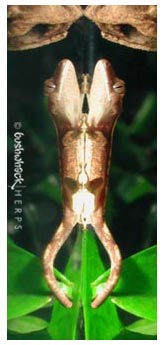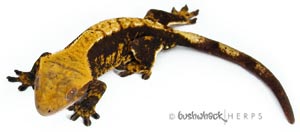[crested gecko overview]
 :: latin name
:: latin name
Correlophus ciliatus (previously Rhacodactylus ciliatus)
:: common name(s)
Crested Gecko; New Caledonian Crested Gecko; Eyelash Gecko
:: origin
New Caledonia - located East of Australia and NW of New Zealand in the Southwestern Pacific Ocean. New Caledonia is made up of a cigar-shaped main island, the Grande Terre, and several smaller islands, including the Isle of Pines. The main island is over 200 miles (320 km) long and about 40 miles (65 km) wide. The climate is tropical, but modified by SE trade winds. Seasonal rains occur during the warm season, during which temperatures reach the upper 70s (24-26°C) with rains tapering off & temperatures staying in the low 70s (21-23°C) during the cool season.
> Map
:: establishment in captive trade
 Correlophus ciliatus was believed by many to be extinct until 1994 when they were rediscovered. Subsequent collections taken from New Caledonia established a breeding population of animals for the pet trade, and Cresteds have been captive bred ever since.
Correlophus ciliatus was believed by many to be extinct until 1994 when they were rediscovered. Subsequent collections taken from New Caledonia established a breeding population of animals for the pet trade, and Cresteds have been captive bred ever since.
:: captive Life
Crested Geckos have adapted extremely well to captive life. They are relatively easy to care for, hardy and easy to breed. The development of complete meal replacement powdered diets has allowed people to raise and care for cresteds without the requirement of live insects. Unlike some species, they don't stress too easily, and tolerate brief handling periods very well. They thrive at common room temperatures, so additional heating & lighting sources are usually not necessary.
> more on crested care
:: colors
In the wild, Crested Geckos are often some shade of buckskin (tan, also known as "normal" coloration) and have little patterning. However, selective breeding of Crested Geckos has, and continues to produce, many different and interesting colors, patterns and structural traits.
 Crested Gecko coloration is highly variable ... intense reds, oranges and yellows are often sought after, but other colors (often in combination with specific colors) are also desirable. Cream (in combination with a brighter color), nearly white (or "moonglow"), nearly black, lavender-grey, and shades of olive-brown (appearing green) are some of the rarer colors that many breeders are working with. Naturally, the rarer the color or color combination at any given time, the greater the value or price on the gecko. But the bottom line is, each person has their own preferences for color & pattern, so pricing & value is determined by what someone is willing to pay for a particular gecko and/or how much the seller is willing to part with it for.
Crested Gecko coloration is highly variable ... intense reds, oranges and yellows are often sought after, but other colors (often in combination with specific colors) are also desirable. Cream (in combination with a brighter color), nearly white (or "moonglow"), nearly black, lavender-grey, and shades of olive-brown (appearing green) are some of the rarer colors that many breeders are working with. Naturally, the rarer the color or color combination at any given time, the greater the value or price on the gecko. But the bottom line is, each person has their own preferences for color & pattern, so pricing & value is determined by what someone is willing to pay for a particular gecko and/or how much the seller is willing to part with it for.
> more on crested morphs
:: "fired up"
Cresteds also have the interesting characteristic of changing color throughout the day. In general, during the daytime hours Crested Geckos exhibit a significantly paler, less intense coloration. At night they often "fire up" to display darker, more vibrant colors with greater contrast. The change can be subtle, or so dramatic that it hardly looks like the same gecko. In addition, some geckos rarely fire up to their full potential, while others seem to always be fired up. Factors that seem to influence this characteristic include light (bright, intense light tends to pale out geckos), temperature (sometimes cooler temperatures cause them to fire up more) and activity/stress level (some geckos fire up more when they are more active or stressed - hunting crickets, breeding, etc.).
:: size
As crested geckos have been selectively bred for bright colors and patterns, they have unfortunately gotten smaller in size (as well as their heads becoming narrower & crests smaller). As a result, many breeders are making an effort to improve the size and structure of the cresteds currently being bred.
So what's a normal size? Adult cresteds that are under or around 30 grams are definitely on the small side. Weights in the mid 30s are fairly common, but ideally cresteds should be a bit bigger ... 40-50 grams would be considered by many to be a nicely sized crested ... but some cresteds are even bigger. Some are in the 60s, 70s and a few can even tip the scales at close to 80 grams.In terms of length, most cresteds are around 4-4.5" (10-11.5 cm) from the tip of their snout to their vent (SVL) and about 7-8" (17.8-20.3 cm) in total length (including tail). Cresteds that are 9" (22.8 cm) or more in total length are considered large.
It's important to note that females should reach a decent size before they are bred, otherwise they are at risk for calcium crash and other serious health problems. Most breeders recommend at least 30 grams, preferably 32-35 grams. These sizes are assuming the crested still has its tail (subtract about 10% or about 4 grams for a missing tail).
:: structure
Sometimes you will see crested geckos described as having "excellent structure." Many times this is referring to gecko's head region. Crested geckos should have a nice wide head with large crests. A stocky build with a nice long, fat tail is also desirable
